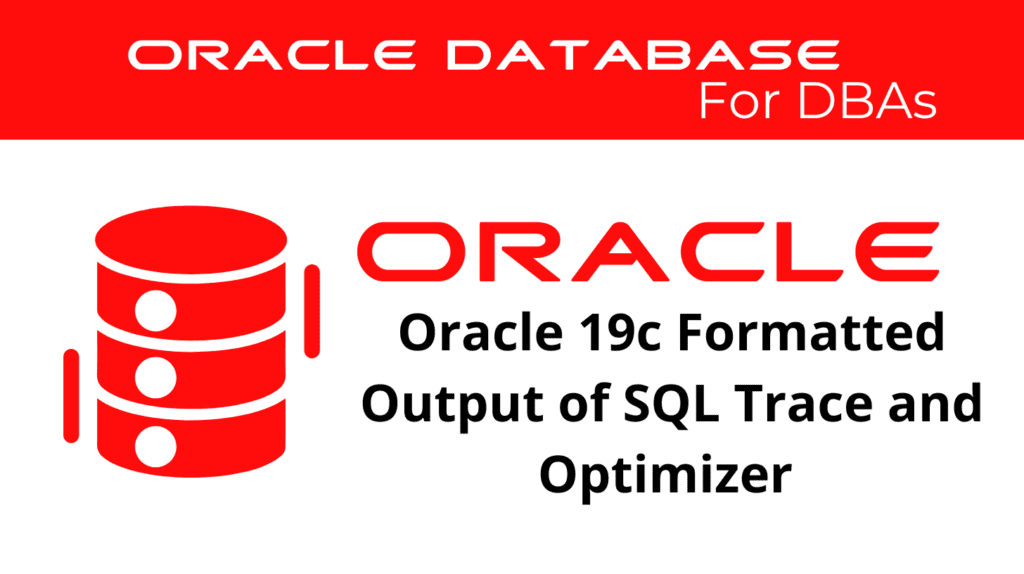
Identifying poorly performing SQL statements is crucial for maintaining optimal database performance in Oracle 19c. Utilizing SQL Trace output and Optimizer Trace output can significantly aid in pinpointing these issues. This guide will delve into the use of formatted outputs from SQL Trace and the Optimizer Trace to enhance SQL performance.
Understanding SQL Trace
SQL Trace provides detailed information about the execution of SQL statements. By examining the SQL Trace output, administrators can identify performance bottlenecks and optimize SQL statements for better performance.
Key Features of SQL Trace
Detailed Execution Data: SQL Trace captures comprehensive data about SQL execution, including wait events and resource consumption.
Performance Metrics: It provides metrics on execution time, CPU usage, and I/O operations.
Event Timing: The trace includes timestamps for each event, helping identify delays and bottlenecks.
Execution Path: It reveals the actual execution path taken by SQL statements.
Enable SQL Trace for a Session:
ALTER SESSION SET SQL_TRACE = TRUE;
This command enables SQL Trace for the current session, capturing detailed execution data for all SQL statements run in the session.
Execute SQL Statements Run the SQL statements you want to analyze. The trace will record their execution details.
Disable SQL Trace:
ALTER SESSION SET SQL_TRACE = FALSE;
Disabling SQL Trace stops the tracing process and finalizes the trace file.
Format the Trace Output Use the tkprof utility to format the raw trace file into a readable report.
tkprof tracefile.trc outputfile.txt
This command generates a formatted report that can be analyzed to identify performance issues.
📢 You might also like: Oracle 19c Monitoring Adaptive and Dynamic Execution Plans (Category: Performance Management and Tuning)
Understanding Optimizer Trace
The Optimizer Trace provides insight into how the Oracle optimizer makes decisions about execution plans. Analyzing the Optimizer Trace output helps understand why certain plans are chosen and identify potential areas for optimization.
Key Features of Optimizer Trace
Decision Details: The Optimizer Trace reveals the decision-making process of the optimizer.
Plan Choices: It shows alternative execution plans considered by the optimizer.
Cost Analysis: The trace includes cost estimates for different plan choices.
Optimization Steps: It details each step taken by the optimizer during the optimization process.
Enable Optimizer Trace:
ALTER SESSION SET EVENTS '10053 TRACE NAME CONTEXT FOREVER, LEVEL 1';
This command enables the Optimizer Trace for the current session, capturing the optimizer’s decision-making process.
Execute SQL Statements Run the SQL statements you want to analyze. The trace will record the optimizer’s decisions.
Disable Optimizer Trace:
ALTER SESSION SET EVENTS '10053 TRACE NAME CONTEXT OFF';
Disabling the Optimizer Trace stops the tracing process and finalizes the trace file.
Format the Trace Output Use the tkprof utility to format the raw trace file into a readable report.
tkprof tracefile.trc outputfile.txt
This command generates a formatted report that can be analyzed to understand the optimizer’s decisions.
Benefits of Using SQL Trace Output and Optimizer Trace Output
Utilizing SQL Trace output and Optimizer Trace output provides numerous benefits for database performance tuning:
Enhanced Performance: Identifying and optimizing poorly performing SQL statements improves overall database performance.
Resource Efficiency: Optimized SQL statements consume fewer resources, reducing operational costs.
Proactive Problem Resolution: Early identification of performance issues allows for timely resolution, preventing potential disruptions.
Insightful Analysis: Detailed trace outputs provide deep insights into SQL execution and optimization processes.
Best Practices
To maximize the benefits of using SQL Trace and Optimizer Trace outputs, consider these best practices:
Regular Monitoring: Continuously monitor SQL performance to detect and resolve issues early.
Format and Analyze Traces: Regularly format and analyze trace outputs to maintain optimal performance.
Educate Developers: Ensure developers understand how to use and interpret trace outputs for performance tuning.
Automate Trace Collection: Use automation tools to streamline the process of collecting and analyzing trace outputs.
Keep Statistics Updated: Regularly gather and update statistics to help the optimizer make accurate decisions.
Conclusion
Using formatted outputs from SQL Trace and Optimizer Trace in Oracle 19c is essential for identifying and resolving poorly performing SQL statements. By leveraging these tools, database administrators can enhance SQL performance, maintain high availability, and proactively address performance issues.
Following best practices and effectively managing trace outputs will help database administrators maintain optimal Oracle 19c environments, meeting the demands of today’s data-driven landscape.
See more on Oracle’s website!
Be Oracle Performance Management and Tuning Certified Professional, this world is full of opportunities for qualified DBAs!





